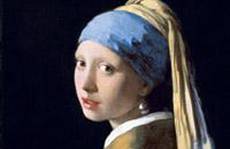BOLOGNA'S WINTER ART SCENE DRAWING ATTENTION
By Sandra Cordon
08 gennaio, 15:51 (ANSA) - Bologna, January 8 - Famous for its food, its
kilometers of porticoes, and its iconic medieval towers, the
city of Bologna is also catching attention for its international
art exhibitions this winter.
(ANSA) - Bologna, January 8 - Famous for its food, its
kilometers of porticoes, and its iconic medieval towers, the
city of Bologna is also catching attention for its international
art exhibitions this winter.The masterpiece 'Girl with a Pearl Earring', by Dutch master Johannes Vermeer, will be a highlight of one of the most highly anticipated art events in the central Italian city.
Advance tickets are selling quickly for the exhibition: "The Myth of the Golden Age, From Rembrandt to Vermeer" which begins February 8 in Bologna's Palazzo Fava and continues through May 25.
But art fans do not need to wait until next month: the city will host Art City Bologna (Arte Fiera) from January 24 to 27, a program of exhibits and cultural events organized by Comune di Bologna with a special focus on works from China and the countries of Eastern Europe. The event also encompasses an exhibition in Bologna's Museum of Modern Art (MAMbo) called "The Great Magic" which continues until February 16 and includes 93 works by masters of the 16th century and the present day, from Dosso Dossi to Gustav Klimt to Edward Weston.
The works belong to the art collection owned by Italy's UniCredit Bank.
Meanwhile, a new art space, the Galleria OltreDimore, opens with a solo exhibition by Maziar Mokhtari, a young Iranian artist who is creating a work with site-specific video installation and photos called Yellow Apocalypse.
Still, the greatest fascination has been around the Golden Age exhibition featuring Vermeer and Rembrandt as representing the Golden Age of Dutch painting in the 17th century.
Ticket vendors say advance bookings for the show have been extremely high, as Bologna is its only European date in the first half of this year and provides a unique opportunity to admire masterpieces by Rembrandt, Hals, and Steen as well as Vermeer.
The exhibition has been travelling while an extensive two-year restoration project continues in the prestigious Mauritshuis museum in The Hague in the Netherlands where the art works normally reside.
The Dutch museum is expected to reopen in June. But the winter art scene comes as a supplement to the numerous other features of Bologna that attract visitors from around the world.
With its roots dating back to the 9th century BC, Bologna has long been an important centre of education, art and culture.
In the year 2000, it was declared the European capital of culture and six years later, it was named a UNESCO "city of music".
The city's social life is enriched by the thousands of international students drawn to the world's oldest existing university, the University of Bologna founded in 1088.
Many other visitors are attracted by the city's longstanding reputation as a centre of fine food and wine, leading to one of Bologna's nicknames "la grassa" or "the fat one"; another popular pet name for the city is "la dotta" or "the learned one".
After feasting on the region's famous meat and cheese dishes, visitors can stroll in any kind of weather sheltered by the 38 kilometers of beautiful porticoes that cover most of the major streets in Bologna's historic centres.
Those strolls can include such highlights as Piazza Maggiore, which is dominated by the massive Basilica of San Petronio, dedicated to the patron saint of the city. Nearby are Bologna's iconic Due Torre, or two historic towers, with one - the Asinelli - open to visitors to climb the 600 steps to the top where sweeping views of the red roofs of Bologna spread below.
Another highlight is the complex of Santo Stefano, which includes seven churches, cloisters, and a treasure trove of Medieval and Renaissance-era finds.
For those who don't mind a somewhat longer hike, they can follow under the porticoes of San Luca stretching from the ancient city walls up to the 17th century Sanctuary of the Madonna di San Luca.
The route, under 666 porticoes, stretches almost four kilometres, linking San Luca to the historic centre and shelters the traditional procession which every year since 1433 has carried a Byzantine icon of the Madonna with Child down to San Petronio during Ascension week.










